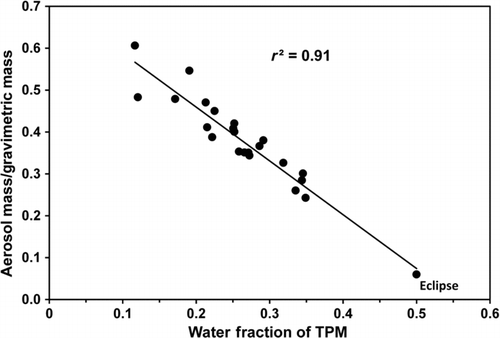Figures & data
TABLE 1 Puff-by-puff data for a 30% filter-ventilated, American blend cigarette smoked using a 60/30/2 regimen. Decreasing CMD, increasing number concentration, and decreasing aerosol mass/gravimetric mass ratios as puff number increases are representative of all products evaluated. ± one standard deviation of 28 replicates is provided
TABLE 2 Select design parameters illustrating the extent of variation among the 29 cigarette types. Numerical values in parentheses indicate nonstandard (∼24–25 mm) circumference values. Average CMD and number concentration (±one standard deviation, n = 5) values were collected using the 60/30/2 smoking regimen
FIG. 1 Plots depicting variation in (a) CMD and (b) particle number concentration among several smoking regimens. 50% VB and 100% VB indicate the extent of filter ventilation hole blocking. The ID numbers found below each grouping correspond to cigarettes identified in Table 2.

FIG. 2 The ratio of particulate matter mass measured by the DMS500 to Cambridge pad TPM measurements plotted as a function of the water fraction of TPM. These data were collected using a 60/30/2 smoking regimen and correspond to complete smoking of each cigarette.

TABLE 3 Aerosol mass/gravimetric mass ratios for various puff number/cigarette type pairs at DMS500 secondary dilution ratios of 75X–200X. Data were collected using the 35/60/2 smoking regimen
FIG. 4 The influence of puff number and smoking regimen on aerosol mass/gravimetric mass ratios of a 30% filter-ventilated American blend cigarette. 100% VB indicates 100% filter ventilation blocking.

FIG. 5 (a) CMD values reported directly by the DMS500, calculated assuming the evaporation of TPM water and only water, and calculated assuming that TPM evaporation occurred to the extent to fully account for aerosol mass/gravimetric mass ratios in Figure 4. (b) Number concentration data directly reported by the DMS500, calculated after adding TPM water back as particle mass and calculated assuming that number concentration underestimation occurred to the extent to fully account for aerosol mass/gravimetric mass ratios in Figure 4, i.e., no evaporation.

